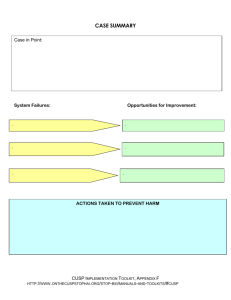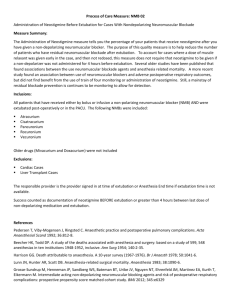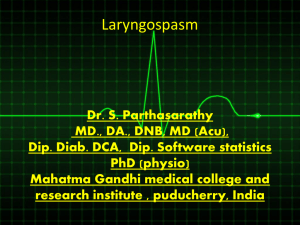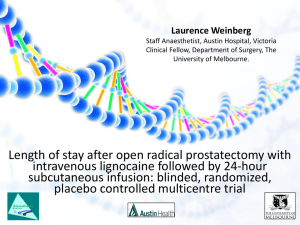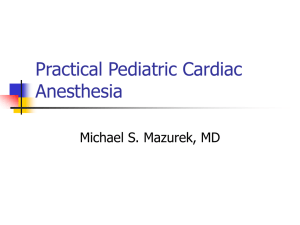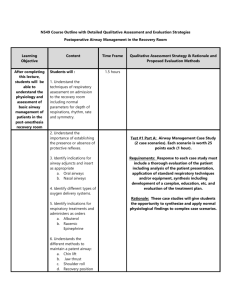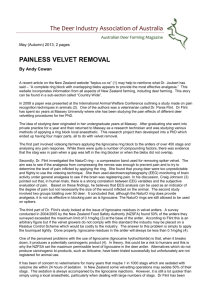attenuation of hemodynamic response to extubation with
advertisement
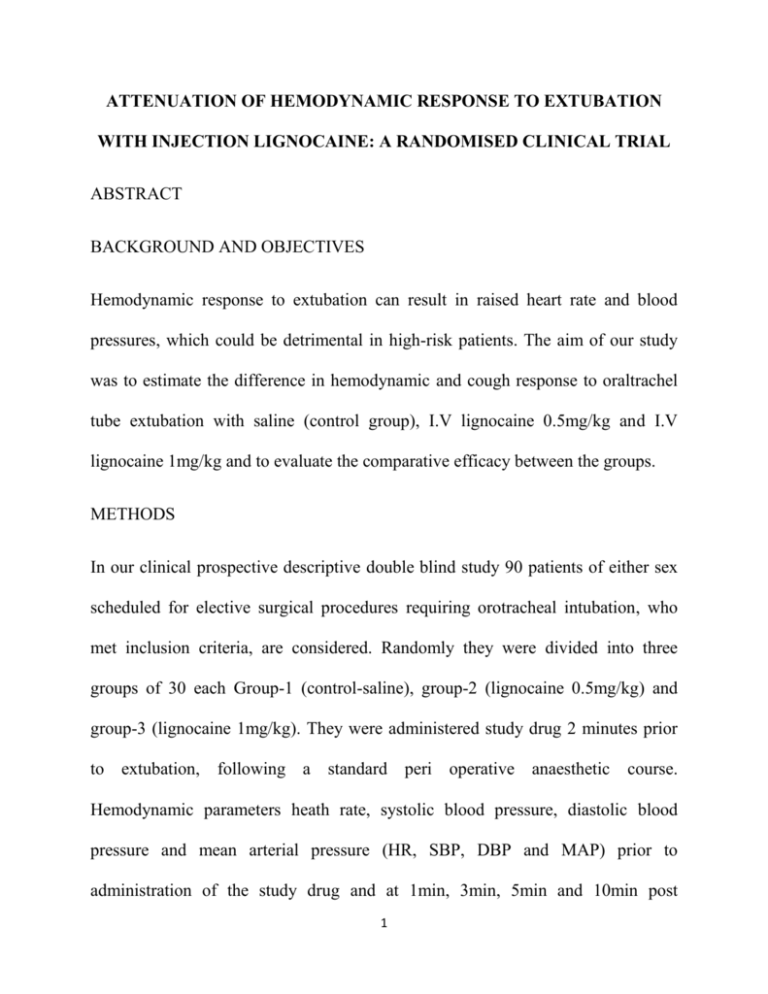
ATTENUATION OF HEMODYNAMIC RESPONSE TO EXTUBATION
WITH INJECTION LIGNOCAINE: A RANDOMISED CLINICAL TRIAL
ABSTRACT
BACKGROUND AND OBJECTIVES
Hemodynamic response to extubation can result in raised heart rate and blood
pressures, which could be detrimental in high-risk patients. The aim of our study
was to estimate the difference in hemodynamic and cough response to oraltrachel
tube extubation with saline (control group), I.V lignocaine 0.5mg/kg and I.V
lignocaine 1mg/kg and to evaluate the comparative efficacy between the groups.
METHODS
In our clinical prospective descriptive double blind study 90 patients of either sex
scheduled for elective surgical procedures requiring orotracheal intubation, who
met inclusion criteria, are considered. Randomly they were divided into three
groups of 30 each Group-1 (control-saline), group-2 (lignocaine 0.5mg/kg) and
group-3 (lignocaine 1mg/kg). They were administered study drug 2 minutes prior
to extubation, following a standard peri operative anaesthetic
course.
Hemodynamic parameters heath rate, systolic blood pressure, diastolic blood
pressure and mean arterial pressure (HR, SBP, DBP and MAP) prior to
administration of the study drug and at 1min, 3min, 5min and 10min post
1
extubation were considered for statistical analysis. Post extubation cough was
graded as per Eshak’s grading (Grade 0, 1, 2 and 3). Data obtained were analysed
using Analysis of variance (ANOVA), Post-hoc Tukey test and Chi-square/Fisher
Exact test.
RESULTS
In control group, there was significant rise in HR, SBP and MAP throughout the
study period and the incidence of moderate and severs cough was 43.3% and 30%
respectively. Diastolic blood pressure and mean arterial pressures attenuation with
lignocaine 1mg/kg found to be superior (P<0.001). There was no significant
difference in heart rate and systolic blood pressure attenuation between patients
who received 0.5mg/kg lignocaine and 1mg/kg lignocaine at 1min (P - 0.101 and P
- 0.938 respectively). Post extubation cough suppression was 100% in patients who
received lignocaine 1mg/kg.
CONCLUSION
Study concludes that lignocaine 1 mg/kg is superior to 0.5 mg/kg in attenuating the
hemodynamic responses to tracheal extubation. For post extubation cough
suppression (100%) lignocaine 1mg/kg is ideal.
KEY WORDS: Extubation, hemodynamic response, attenuation, lignocaine.
2
INTRODUCTION
Physiologic responses to emergence from anaesthesia and tracheal extubation
include unwanted circulatory and airway reflexes. Is due to lighter planes of
anaesthesia with inadequate analgesia, which result in tachycardia, hypertension,
coughing, bucking, laryngospasm and bronchospasm.1,2,3
In the clinical practice respiratory complications after tracheal extubation are three
times more common than during tracheal intubation and induction of anaesthesia
(12.6% vs. 4.6%).4
Significant decreases in ejection fractions (from 55% ± 7% to 45% ± 7%) after
extubation without electrocardiographic signs of myocardial ischemia is
demonstrated with coronary artery disease patients.2,5
Sympathetic stimulation during extubation may be detrimental, due to increased
myocardial oxygen demand, subjecting the patient to have arrhythmia, myocardial
ischemia, and infarction, pulmonary oedema, cerebral haemorrhage, etc. These
responses are marked in hypertensive patients, coronary artery disease patients and
cerebrovascular disease patients.6,7,8
Bucking
and
coughing
frequently
occurs
during
extubation.
Bucking
physiologically mimics Valsalva manoeuvre. It could cause negative pressure
pulmonary oedema if lung volumes are less than vital capacity. They also cause
3
abrupt
increases
in
intracavitary
pressures
(intraocular,
intrathoracic,
intraabdominal, and intracranial) which could put patient at high risk.9,10
To blunt above mentioned hemodynamic and cough responses to extubation,
several pharmacological strategies and extubation in deeper planes of anaesthesia
have been studied.11,12 Each one has its own merits and demerits.
In our study we had considered lignocaine in view of its action and to find the
clinical effective dose to practice. It produces central sedation, suppresses
autonomic reflexes, potentiates analgesia and may protect the ischemic
myocardium from ultra structural damage associated with high circulating
catecholamine levels.13
The aim of our study was to estimate the difference in hemodynamic and cough
response to oraltrachel tube extubation with saline (control group), I.V lignocaine
0.5mg/kg and I.V lignocaine 1mg/kg and to evaluate the comparative efficacy
between the groups.
METHODOLOGY
The randomized prospective double blind single centre study, was undertaken at
tertiary care hospital after obtaining hospital ethical committee approval and
informed written consent from the patients. The study included 90 patients of
either sex of ASA (American Society of Anaesthesiologist) grade I and II, with
4
airway assessment of Mallampatti grade 1 and 2, between the age group of 18-60
years, scheduled for elective surgeries under general anaesthesia posted for
General Surgery, ENT (ear, nose and throat), Orthopaedic, Gynaecological, Plastic
and Neurosurgical procedures requiring oral intubation. Patients were excluded if
they were unwilling to participate, history of allergy to any drug, emergency
surgeries, patients on beta blockers or calcium channel blockers, patients with
bronchial asthma and cardiovascular disease, patients with documented intra
operative hemodynamic compromise, patients with active upper respiratory tract
infection, sore throat and history of laryngeal/tracheal surgery or pathology.
Randomisation was done using random number table and were divided into three
groups (n=30) Group-1 (control-saline), group-2 (lignocaine 0.5mg/kg) and group3 (lignocaine 1mg/kg) to administer study drug 2 minutes prior to extubation. Two
senior residents who were not involved in patient care generated random sequence
and they were sequentially numbered. For blinding purpose, study drug was
prepared in 5ml saline in a 5cc syringe and labelled with sequential number.
Anaesthesiologist blinded to the study administered the study drug, recorded
parameters and rating of post extubation cough. Patients were, blinded to the study
drug. Samples were, decoded for statistical analysis after the completion of the
study.
5
The incidence of post extubation cough was evaluated using a 4-point rating scale
suggested by Eshak.14 Grade 0 = no coughing or straining, Grade 1= moderate
coughing, Grade 2 = marked coughing, straining and Grade 3 = poor extubation
with laryngospasm.
On the day of surgery, confirming the pre-anaesthetic check-up, patients were
mobilised to the operation theatre. Securing the I.V line all patients were, started
on maintenance fluid (ringer’s lactate). All patients were monitored with pulse
oximetry, non-invasive blood pressure, electrocardiography and end tidal carbon
dioxide throughout the surgery.
Premedication,
induction,
maintenance
and
perioperative
analgesia
was
standardised in all three groups. At the conclusion of the surgery residual
neuromuscular blockade was reversed with inj Glycopyrolate 6µg/kg and inj
neostigmine 0.05mg/kg when swallowing reflex was present, followed by study
drug (either normal saline or inj Lignocaine 0.5mg/kg or inj Lignocaine 1mg/kg).
Patients were extubated 2min after the study drug administration, establishing
adequate tidal volume and oropharyngeal suctioning. Patients were, assessed
clinically for eye opening, and handgrip before extubation. At the time of
extubation patients were assessed for the incidence of post extubation cough using
4-point scale suggested by Eshak. Following extubation patients were, oxygenated
with 100% oxygen through facemask for 5min. Later patients were, shifted to
6
recovery room. HR, SBP, DBP and MAP recorded just before reversal (base line
value) and 1min, 3min, 5min and 10min following extubation was, considered for
statistical analysis.
Descriptive statistical analysis was, carried out in our study. Results on continuous
measurements were, presented on Mean±SD (min-max). Significance was,
assessed at 5% level of significance. Analysis of variance (ANOVA) was, used to
find the significance of study parameters between the three groups of patients.
Post-hoc Tukey test was, employed to find the pair wise significance. Chisquare/Fisher Exact test was, used to find the significance of study parameters on
categorical scale between two or more groups. For analysis,
+
Suggestive
significance (P value: 0.05<P<0.10), * moderately significant (P value: 0.01<P
0.05) and ** strongly significant (P value: P0.01).
ANALYSIS
The demographic characteristics age, sex, weight, ASA grade and duration of
surgery are, detailed in table I and samples are matching each other statistically.
In all three groups rise in HR, DBP and MAP were statistically significant
throughout the study period in comparison with base line values, but SBP was
comparable with base line values at 10min.
DBP and MAP attenuation was
superior with lignocaine 1mg/kg (Table 2, 3, 4 and 5) (p < 0.001). Post extubation
7
cough suppression was 100% in patients who received lignocaine 1mg/kg (Table
6).
Fall in HR, SBP, DBP and MAP between group-1 and group-3 was statistically
significant up to 5min. At 10min fall in SBP was comparable between the groups.
Comparison between group-1 and group-2, in group-2 there was significant fall in
HR and SBP up to 5min (p <0.001), whereas DBP and MAP were inconsistent
(Table 2, 3, 4 and 5). There was no statistically significant difference in HR
between group-2 and group-3 except for recordings at 1min (Figure 1). Infers that
lignocaine 0.5mg/kg and 1mg/kg both are effective in suppressing the HR.
However, comparison between group-1 and group-3 there was statistically
significant difference in the HR (p < 0.001) (Table 2). Fall in SBP, DBP and MAP
between group-2 and group-3 are not statistically significant throughout the study
period (Table 3 and 4). The mean arterial pressures were blunted best in group-3 at
1min, 3min and 5 min post extubation in comparison with group-1{(p<0.001)
(Table 5) (Figure 2)}. In conclusion, lignocaine 1mg/kg significantly attenuates the
presser response compared to lignocaine 0.5mg/kg and control group.
Post extubation cough suppression was 100% in group-3 where as it was 56.7% in
group-2 and 26.7% in group-1. Severe cough documented was 30% in group-1 and
13.3% in group-2 (Table 6). By the clinical observation lignocaine 1mg/kg was
ideal in attenuating cough responses to tracheal extubation.
8
In conclusion, lignocaine 1mg/kg significantly attenuates the presser and cough
response compared to control group. It is also clinically more effective than
0.5mg/kg lignocaine.
DISCUSSION
Significant increase in HR, MAP, cardiac index, systemic vascular resistance,
pulmonary artery pressure and unwanted air way reflexes have been observed in
response to tracheal extubation, which persist into the recovery period.3 Bidwai et
al8 and Dyson et al15 demonstrated increases of 20% or more in these
hemodynamic variables following extubation in normotensive patients.
Lignocaine attenuates the hemodynamic response to tracheal extubation by its
direct myocardial depressant effect, central stimulant effect, and peripheral
vasodilatory effect and finally it suppresses the cough reflex, an effect on synaptic
transmission.16 So we had considered lignocaine in our study.
Mahmood Saghaei et al17 has done 2 phases study on 200 adult patients, randomly
divided into two groups to receive either IV lignocaine 1mg/kg or normal saline as
placebo. Post extubation cough, were compared between the two groups. In the
study population patients who had cough were, randomly divided into 2 groups to
receive IV lignocaine 0.5mg/kg or saline to abort the cough. Portion of patients,
with successful response to lignocaine 0.5mg/kg were, compared with 1mg/kg
9
lignocaine group. Outcome result of the study was, prophylactic administration of
lignocaine prior to extubation could be ineffective in preventing post extubation
cough. Recommendation was, to treat cough upon occurrence, instead of routine
prophylactic administration of lignocaine. In this study, the comparison was
between 1gm/kg and 0.5mg/kg I.V lignocaine. Outcome does not suggest, which
dose is ideal to suppress cough reflex. Keeping it in view, we had considered
3groups in our study. Group I control (saline), Group II (lignocaine 0.5mg/kg) and
Group III (lignocaine 1mg/kg).
Hamaya et al18 reported that the maximal plasma lignocaine concentration was 4.3
- 2.5µg/mL 5 minutes after IV injection of lignocaine 1mg/ kg. It is more than the
plasma concentration required to suppress cough reflex (2.3µg/mL). Cough
suppression was 100% with lignocaine 1mg/kg in our study. This explains
lignocaine 1mg/kg is the clinical dose to suppress cough.
Bidwai AV, Stanley TH, and BidwaiVA8 did a study on heart rate and blood
pressure response to endotracheal extubation with I.V lignocaine 1mg/kg and
control group (saline). Patients in lignocaine group did not sustain significant
elevation in HR or SBP at or after extubation compared with saline group.
Considering the above two references, we chose 1mg/kg lignocaine as one of our
study drug dose.
10
Lidocaine when administered I.V has an onset of action within 45-30 seconds with
peak effect at 1-2 min. Mikawa et al19 reported that IV lignocaine two minutes
prior to tracheal extubation attenuates increases in HR, SBP, DBP and the cough
reflex. Considering it, in our study we administered the study drug 2min prior to
extubation.
Lowrie et al20 evaluated the impact of tracheal extubation on changes in plasma
concentrations of epinephrine and Norepinephrine in 12 patients undergoing major
elective surgery. They found significant increase in epinephrine levels from 0.9 to
1.4 pmol/mL 5min, after extubation. In our study in all three groups HR had
increased at 1min following extubation. Explanation could be due to increase in
plasma epinephrine levels.
Fujii et al21 did a randomized double blind study on hypertensive (ASA 2) patients
undergoing elective orthopaedic surgeries with 0.2mg/kg diltiazem or 1mg/kg
lignocaine IV or both together before tracheal extubation. Hemodynamic changes
were less in patients receiving diltiazem plus lignocaine than in those receiving
diltiazem or lignocaine as sole agent. In our study too, lignocaine 1mg/kg was not
effective in suppressing hemodynamic response to extubation.
C.S.Sanikop22 in his study on pre extubation intravenous lignocaine 2mg/kg, to
prevent post extubation laryngospasm in children operated for cleft lip and cleft
11
palate surgery found HR, BP and oxygen saturation being well maintained at 1min,
2min, 3min, 5min and 10min following administration of I.V lignocaine. In our
study, observations are comparable with lignocaine 1mg/kg.
Chandra K. Pandey et al23 studied the effects of lignocaine 1.5mg/kg to suppress
fentanyl (3µg/kg) induced cough in a randomized double blind pattern. Lignocaine
administered 1min prior to fentanyl, had significantly reduced fentanyl induced
cough in comparison with placebo. In our study, we had administered lignocaine
1mg/kg 2min prior to extubation to suppress post extubation cough. Cough
suppression was 100% in our study group.
CONCLUSION
Based on the present clinical comparative study the following conclusions are
drawn.
With lignocaine 1mg/kg rise in HR, SBP, DBP and MAP were 11.02%, 3.64%,
8.13%, and 5.72% at 3 minutes post extubation compared to pre extubation values.
Where as in control group it was 45.29%, 21.09%, 20.31% and 21.57%
respectively, which is statistical strongly significant (p < 0.001)
Post extubation cough suppression was 100% with lignocaine 1mg/kg, which was
56.7% with 0.5mg/kg lignocaine and 26.7% with saline (control group).
12
Inference from our study is, lignocaine 1mg/kg is superior to 0.5 mg/kg in
attenuating the hemodynamic responses to tracheal extubation, which is
statistically highly significant (p < 0.001). For post extubation cough suppression
(100%) lignocaine 1mg/kg is ideal.
13
BIBLIOGRAPHY
1. Elia S,Liu P,Chrusciel C,Hilgenberg A,Skourtis C, Lappas D Effects of
tracheal extubation on coronary blood flow, myocardial metabolism and
systemic hemodynamic responses Can J Anaesth 1989;36(1):2-8.
2. Wellwood M, Aylmer A, Teasdale S Extubation and myocardial
ischemia.Anesthesiology 1984; 61:A132.
3. Wohlner
EC,Usabiaga
LJ,Jacoby
RM
cardiovascular
effects
of
extubation,Anaesthesiology1979;51:S194
4. Karmarkar S, Varshney S. Tracheal extubation Continuing Education in
Anaesthesia, Critical Care & Pain 2008; 8(6):214-20.
5. Coriat I’, Mundler 0, Bousseau D, et al. Response of left ventricular ejection
fraction to recovery from general anaesthesia :measurement by gated
radionuclide angiography.Anesth Analg 1986; 65:593-600.
6. Fleisher LA. Peroperative myocardial ischemia and infarction. Int
Anaesthesiol Clin 1994; 4: 1-15.
7. Gill NP, Wright B, Reilly CS. Relationship between hypoxemia and cardiac
ischemic events in the peroperative period. Br JAnaesth 1992; 68: 471-473.
14
8. Bidwai AV, Bidwai VA, Rogers CR, Stanley TH. Blood-pressure and pulserate responses to endotracheal extubation with and without prior injection of
lidocaine. Anesthesiology 1979; 51:171-3.
9. White PF, Schlobohm RM, Pitts LH, Lindauer JM. A randomized study of
drugs for preventing increases in intracranial pressure during endotracheal
suctioning. Anesthesiology 1982;57242-4.
10.Yang KL, Tobin MJ. A prospective study of indexes predicting the outcome
of trials of weaning from mechanical ventilation Engl J Med 1991;324:144550.
11. Balbir C,Naveen M,Manoj B,Gopal K Haemodynamic response to
extubation:attenuation with propofol, lignocaine and esmolol. J Anaesth Clin
Pharmacol 2003; 19(3): 283-288.
12. M. Popat, V. Mitchell, R. Dravid, A. Patil, C. Swampilli & A. Higgs.
Difficult airway society guidelines for the management of tracheal
extubation. Anaesthesia 2012;67:318-340
13. Schaub RG, Lenole CM, Pinder GC, et al: Effects of lidocaine and
epinephrine on myocardial preservation following cardiopulmonary bypass
in the dog. J Thorac Cardiovasc Surg 1977; 74:571-76
15
14. Eshak Y,Khalid A,Bhatti TH small dose of propofol attenuates
cardiovascular responses to tracheal extubation. Anesth Analg1998;86:S5
15. Dyson A, Isaac PA, Pennant JH, et al. Esmolol attenuates Cardiovascular
responses to extubation. Anesth Analg 1990; 71: 675-8.
16. Abou Madi MN,Keszler H,Yacoub JM.Cardiovascular reactions to
laryngoscopy and tracheal intubation following small and large intravenous
doses of lidocaine. Can anaesth Soc J. 1977 Jan; 24(1):12-19
17. Mahmood S,Akbar R,Hassanali S. prophylactic versus therapeutic
administration of intravenous lidocaine for suppression of post extubation
cough following cataract surgery: a randomized double blind placebo
controlled clinical trial. Acta Anaesthesiol Taiwanica 2005;43:205-209.
18. Hamaya Y, Dohi S. Differences in cardiovascular response to airway
stimulation at different sites and blockade of the responses by lidocaine.
Anesthesiology 2000;93:95–103.
19. Mikawa K, Nishina K, Takao Y, et al. Attenuation of cardiovascular
responses to tracheal extubation: comparison of verapamil,lidocaine, and
verapamil-lidocaine combination. Anesth Analg 1997;85:1005–10.
20. Lowrie A, Johnston PL, Fell D, Robinson SL. Cardiovascular and plasma
catecholamine responses at tracheal extubation. Br J Anaesth 1992; 68:2613.
16
21. Fujii Y, Saitoh Y, Takahashi S, Toyooka H. Combined diltiazem and
lidocaine reduces cardiovascular responses to tracheal extubation and
anesthesia emergence in hypertensive patients.Can J Anaesth 1999;46:952–
6.
22. Sanikop CS One year randomized placebo controlled trial to study the
effects of intravenous lidocaine in prevention of post extubation
laryngospasm in children following cleft lip and cleft palate surgeries .Indian
J Anaesth. 2010 Mar-Apr; 54(2): 132–136
23. Chandra K, Mehdi R, Rajeev R Intravenous lidocaine suppresses fentanylinduced coughing: a double blind, prospective, randomized placebocontrolled study. Anaesth Analg 2004; 99:1696-8.
17
Table 1: Patients data.
Age (Years)
Male/Female
Weight (kg)
ASA I/II
Duration of
surgery(hrs)
Group I
38.60±11.64
18/12
Group II
42.50±12.03
11/19
Group III
40.30±10.21
14/16
61.10±8.27
20/10
3.50±1.36
62.17±7.06
16/14
2.68±1.05
58.20±7.83
17/13
2.98±1.39
Table 2: Comparison of heart rate in three groups
Table 3: Comparison of SBP (mm Hg) in three groups
18
Table 4: Comparison of DBP (mm Hg) in three groups
Table 5: Comparison of MAP (mm Hg) in three groups
Table 6: Comparison of Cough in three groups
Cough
No cough
Moderate cough
Severe cough
Poor extubation with
larryngospasm
Total
Group-I
8(26.7%)
13(43.3%)
9(30.0%)
Group-II
17(56.7%)
9(30.0%)
4(13.3%)
Group-III
30(100%)
0
0
0
30(100%)
0
30(100%)
0
30(100%)
19
Graphs depicting mean heart rate changes
140
120
HR (bpm)
100
80
60
Group I
40
Group II
Group III
20
0
Baseline
1 minute
3 minutes
5 minutes
10 minutes
Figure 1
Graphs depicting mean arterial changes
120
MAP (mm hg)
100
80
60
Group I
Group II
40
Group III
20
0
Baseline
1 minute
3 minutes
Figure 2
20
5 minutes
10 minutes
